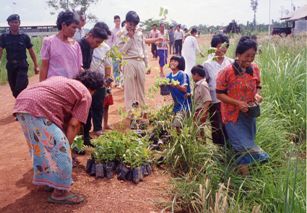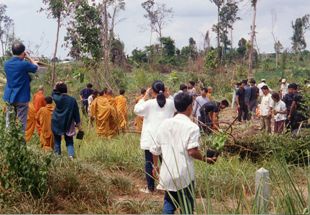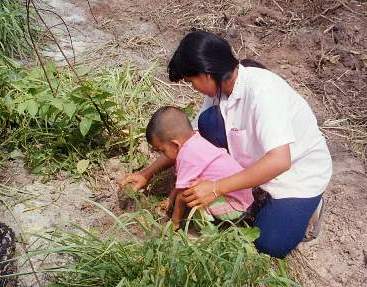


Growing multipurpose trees
on small farms
This manual aims to provide readily understandable technical information to extension workers so they can respond to farmers' questions on how to grow and manage multipurpose trees for household use or local markets.
The manual is, for the most part, a technical reference. However, it also advocates a collaborative process that makes adjustments for local social and economic conditions. Without careful consideration of these and other factors, no tree-planting program, however technically sound, can succeed.
How this manual is organized
This manual is designed so that it can be used for both training and extension purposes. Each module includes a statement of its intended purpose and reminds the reader of the most important points covered. The modules also include a list of suggested readings for those who wish to learn more about the topic.
For convenience in the field, the modules are packaged into 9 pocket-sized volumes. The first series is concerned with establishing MPTS plantings.
This includes modules on
-
Small plantations of multipurpose trees
-
Tending multipurpose trees
-
Harvesting crops of multipurpose trees
-
Selling tree crops
-
Principles of effective extension
-
Fact sheets on multipurpose tree species
The Species Fact Sheets summarize what we know about selected multipurpose tree species in the Asian region. Each entry describes the origin of the species, its ecology, a botanical description, a summary of its advantages and disadvantages, its management, and agroforestry uses.
These "fact sheets" are indexed in 8 languages and include botanical drawings for identification.
About the fact sheets >>
The rest will be added as time and funds permit!
Acknowledgements
Growing Multipurpose Trees on Small Farms
is based on: Foresty/Fuelwood Research and
Development Project. 1994. Growing multipurpose trees on small farms
(2nd ed). Bangkok, Thailand: Winrock International. 320 pp. ISBN
0-933595-88-3
Editing and design: Andre McNicoll (first edition) James H French
(second edition). Contributing editors: Charit Tinsabadh, David Taylor,
Frank Byrnes, Fuh-Jiunn Pann, Henry Wood, Hsu-Ho Chung, Kamis Awang,
Rodel Lasco, Suree Bhumibhamon, Wyatt Latimer.
Published by: Multipurpose Tree Research Network & Forestry/Fuelwood
Research and Development Project (terminated in 1994, it was based at
the Faculty of Forestry Kasetsart University, Bangkok 10900, Thailand)
Contributing
organisations: United States Agency for International Development, Winrock
International Institute for Agricultural Development.
The original acknowledgements
The current version of Growing MPTS on Small Farms was funded by USAID Project No. DHR5547-A-00-0018-00 and the Winrock International Institute for Agricultural Development. The FAO Regional Wood Energy Development Programme provided funding for production of the first version.
A number of organizations have allowed use of their materials in preparation of this manual. These include CARE, the International Centre for Research on Agroforestry (ICRAF), the International Institute for Rural Reconstruction (IIRR), the Nitrogen Fixing Tree Association (NFTA), and World Neighbors.
Information for the species fact sheets was compiled primarily from NFTA's NFT Highlights, ICRAF's Multipurpose Tree and Shrub Database, Wageningen Agricultural University's Tree Species for Tropical Agroforestry Systems, The Prosea Foundation, and IIRR's Resource Book on Sustainable Agriculture for the Uplands.
Mr. Wyatt Latimer of the US Peace Corps compiled the first version of the fact cards while Henry Wood expanded and revised these based on feedback from Dr JK Chaturvedi and other experienced foresters in the region. Technical review was done by Dr Rick J Van Den Beldt and other secretariat staff. Assistance in proofreading was generously provided by Norma Adams and Rita Butler.
On the production end of things, Ms Leela Wuttikraibundit was responsible for layout, typesetting, and production. Mr Manoo Pohsomboon helped with artwork while Ms Apinya Chaivatanasirikul and Ms Sopapan Varasarin assisted with typing.
Finally, Dr Tom Niblock provided consistent inspiration and support to bring
this idea to fruition.
James H. French
Communications /Publications Officer F/FRED, Bangkok, Thailand.
1994
The Multipurpose Tree Species Research Network in Asia produced the manual with support from a number of national and international agencies in the region. This Network consisted of a group of scientists and institutions in Asia who had the shared goal of improving the production of trees that meet the needs of small-farm households.
The Network included scientists in 11 countries. Participants conducted research on MPTS assessment, improvement, management, and related applied social science research topics. Research was complemented by training, network development, germplasm exchange, and preparation of publications.
A secretariat managed the Network out of Kasetsart University's Faculty of Forestry, Bangkok, Thailand. It received technical assistance since its inception in 1986 from the Winrock International Institute for Agricultural Development. This was made possible under a cooperative agreement between the United States Agency for International Development (USAID), the Government of Thailand, and Kasetsart University.